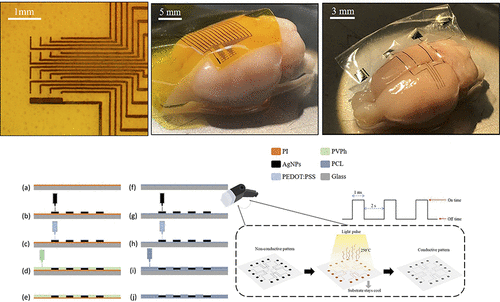当前位置:
X-MOL 学术
›
ACS Appl. Bio Mater.
›
论文详情
Our official English website, www.x-mol.net, welcomes your
feedback! (Note: you will need to create a separate account there.)
Highly Flexible Single-Unit Resolution All Printed Neural Interface on a Bioresorbable Backbone
ACS Applied Bio Materials ( IF 4.6 ) Pub Date : 2020-09-14 , DOI: 10.1021/acsabm.0c00895 Reem M Almasri 1 , Walid AlChamaa 1 , Ali Reza Tehrani-Bagha 2 , Massoud L Khraiche 1
ACS Applied Bio Materials ( IF 4.6 ) Pub Date : 2020-09-14 , DOI: 10.1021/acsabm.0c00895 Reem M Almasri 1 , Walid AlChamaa 1 , Ali Reza Tehrani-Bagha 2 , Massoud L Khraiche 1
Affiliation

|
Neural interfaces are the parts of the neural prosthesis that are in contact with the target tissue. The mechanical, chemical, and electrical properties of these interfaces can be a major determinant of the life of the implant and the neural tissue for chronic and even acute integrations. In this work, we developed a fully inkjet-printed, flexible neural interface on a bioresorbable backbone capable of recording high-fidelity neural activity. We utilized room temperature fabrication processes that overcome the limitations of semiconductor fabrication techniques for processing low-melting point polymers while maintaining high spatial and single-cell recording resolution. The ∼8 μm-thick devices in this study were fabricated onto two flexible polymers: (a) polyimide (PI), a biocompatible polymer commonly used for neural interfaces, and (b) polycaprolactone (PCL), a bioresorbable polyester with outstanding mechanical properties. Electrodes for neural recording were built at 30, 50, 75, and 100 μm diameter using silver nanoparticles/(3,4-ethylenedioxytiophene)–poly(styrenesulfonate) (AgNPs/PEDOT:PSS), which through our process achieved the lowest impedance reported in the literature reaching ∼200 Ω at 1 kHz for a 50 μm electrode diameter. We further enhanced the electrochemical performance of AgNPs/PEDOT:PSS by an order of magnitude by incorporating exfoliated graphene into the electrodes. The biocompatibility of the fabricated devices and their ability to record single-unit activity were confirmed by in vitro tests on both rat PC12 cells and isolated neural rat retina, respectively.
中文翻译:

生物可吸收主干上高度灵活的单单元分辨率全印刷神经接口
神经接口是与目标组织接触的神经假体的部分。这些界面的机械、化学和电学特性可能是植入物寿命和慢性甚至急性整合的神经组织的主要决定因素。在这项工作中,我们在能够记录高保真神经活动的生物可吸收骨架上开发了一种完全喷墨打印的灵活神经接口。我们利用室温制造工艺克服了半导体制造技术在加工低熔点聚合物方面的局限性,同时保持高空间和单细胞记录分辨率。本研究中约 8 μm 厚的器件被制造在两种柔性聚合物上:(a)聚酰亚胺(PI),一种常用于神经接口的生物相容性聚合物,(b) 聚己内酯 (PCL),一种具有出色机械性能的生物可吸收聚酯。使用银纳米粒子/(3,4-乙烯二氧噻吩)-聚(苯乙烯磺酸盐)(AgNPs/PEDOT:PSS)构建直径为 30、50、75 和 100 μm 的神经记录电极,通过我们的工艺实现了报告的最低阻抗在文献中,对于 50 μm 的电极直径,在 1 kHz 时达到 ~200 Ω。我们通过将剥离的石墨烯结合到电极中,进一步将 AgNPs/PEDOT:PSS 的电化学性能提高了一个数量级。制造设备的生物相容性及其记录单单元活动的能力通过以下方式得到证实 和 100 μm 直径使用银纳米粒子/(3,4-乙烯二氧噻吩)-聚(苯乙烯磺酸盐)(AgNPs/PEDOT:PSS),通过我们的工艺实现了文献中报道的最低阻抗,在 1 kHz 时达到 200 Ω,50微米电极直径。我们通过将剥离的石墨烯结合到电极中,进一步将 AgNPs/PEDOT:PSS 的电化学性能提高了一个数量级。制造设备的生物相容性及其记录单单元活动的能力通过以下方式得到证实 和 100 μm 直径使用银纳米粒子/(3,4-乙烯二氧噻吩)-聚(苯乙烯磺酸盐)(AgNPs/PEDOT:PSS),通过我们的工艺实现了文献中报道的最低阻抗,在 1 kHz 时达到 200 Ω,50微米电极直径。我们通过将剥离的石墨烯结合到电极中,进一步将 AgNPs/PEDOT:PSS 的电化学性能提高了一个数量级。制造设备的生物相容性及其记录单单元活动的能力通过以下方式得到证实 通过将剥离的石墨烯结合到电极中,PSS 提高了一个数量级。制造设备的生物相容性及其记录单单元活动的能力通过以下方式得到证实 通过将剥离的石墨烯结合到电极中,PSS 提高了一个数量级。制造设备的生物相容性及其记录单单元活动的能力通过以下方式得到证实分别对大鼠 PC12 细胞和分离的神经大鼠视网膜进行体外试验。
更新日期:2020-10-21
中文翻译:

生物可吸收主干上高度灵活的单单元分辨率全印刷神经接口
神经接口是与目标组织接触的神经假体的部分。这些界面的机械、化学和电学特性可能是植入物寿命和慢性甚至急性整合的神经组织的主要决定因素。在这项工作中,我们在能够记录高保真神经活动的生物可吸收骨架上开发了一种完全喷墨打印的灵活神经接口。我们利用室温制造工艺克服了半导体制造技术在加工低熔点聚合物方面的局限性,同时保持高空间和单细胞记录分辨率。本研究中约 8 μm 厚的器件被制造在两种柔性聚合物上:(a)聚酰亚胺(PI),一种常用于神经接口的生物相容性聚合物,(b) 聚己内酯 (PCL),一种具有出色机械性能的生物可吸收聚酯。使用银纳米粒子/(3,4-乙烯二氧噻吩)-聚(苯乙烯磺酸盐)(AgNPs/PEDOT:PSS)构建直径为 30、50、75 和 100 μm 的神经记录电极,通过我们的工艺实现了报告的最低阻抗在文献中,对于 50 μm 的电极直径,在 1 kHz 时达到 ~200 Ω。我们通过将剥离的石墨烯结合到电极中,进一步将 AgNPs/PEDOT:PSS 的电化学性能提高了一个数量级。制造设备的生物相容性及其记录单单元活动的能力通过以下方式得到证实 和 100 μm 直径使用银纳米粒子/(3,4-乙烯二氧噻吩)-聚(苯乙烯磺酸盐)(AgNPs/PEDOT:PSS),通过我们的工艺实现了文献中报道的最低阻抗,在 1 kHz 时达到 200 Ω,50微米电极直径。我们通过将剥离的石墨烯结合到电极中,进一步将 AgNPs/PEDOT:PSS 的电化学性能提高了一个数量级。制造设备的生物相容性及其记录单单元活动的能力通过以下方式得到证实 和 100 μm 直径使用银纳米粒子/(3,4-乙烯二氧噻吩)-聚(苯乙烯磺酸盐)(AgNPs/PEDOT:PSS),通过我们的工艺实现了文献中报道的最低阻抗,在 1 kHz 时达到 200 Ω,50微米电极直径。我们通过将剥离的石墨烯结合到电极中,进一步将 AgNPs/PEDOT:PSS 的电化学性能提高了一个数量级。制造设备的生物相容性及其记录单单元活动的能力通过以下方式得到证实 通过将剥离的石墨烯结合到电极中,PSS 提高了一个数量级。制造设备的生物相容性及其记录单单元活动的能力通过以下方式得到证实 通过将剥离的石墨烯结合到电极中,PSS 提高了一个数量级。制造设备的生物相容性及其记录单单元活动的能力通过以下方式得到证实分别对大鼠 PC12 细胞和分离的神经大鼠视网膜进行体外试验。











































 京公网安备 11010802027423号
京公网安备 11010802027423号